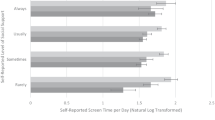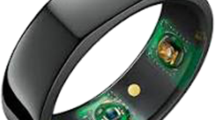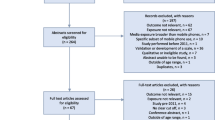Abstract
Objectives
To assess the type and incidence of subjective symptoms related to the use of mobile phones in Polish users.
Material and Methods
The study was conducted in 2005 using a questionnaire survey. Although it has been quite a long time, up to now, no such data have been published for Poland. The questionnaire consisted of 53 questions concerning sex, age, education, general health, characteristics of a mobile phone (hand-held, loud-speaking unit) as well as the habits associated with its use (frequency and duration of calls, text messages, etc.) and complaints associated with using a mobile phone.
Results
As many as 1800 questionnaires were sent. The response was obtained from 587 subjects aged 32.6±11.3 (48.9% women, 51.1% men); the age did not differ significantly between men and women. The subjects owned a cell phone for an average of 3 years. Majority of the respondents used the phone intensively, i.e. daily (74%) or almost daily (20%). Headaches were reported significantly more often by the people who talked frequently and long in comparison with other users (63.2% of the subjects, p = 0.0029), just like the symptoms of fatigue (45%, p = 0.013). Also, the feeling of warmth around the ear and directly to the auricle was reported significantly more frequently by the intensive mobile phone users, compared with other mobile phone users (47.3%, p = 0.00004 vs. 44.6%, p = 0.00063, respectively). Most symptoms appeared during or immediately after a call and disappeared within 2 h after the call. Continuous headache, persisting for longer than 6 h since the end of a call, was reported by 26% of the subjects.
Conclusions
Our results show that the mobile phone users may experience subjective symptoms, the intensity of which depends on the intensity of use of mobile phones.
Similar content being viewed by others
References
Kesari KK, Siddiqui MH, Meena R, Verma HN, Kumar S. Cell phone radiation exposure on brain and associated biological systems. Indian J Exp Biol. 2013;51:187–200.
ICNIRP Guidelines for limiting exposure to time-varying electric, magnetic and electromagnetic fields (up to 300 GHz). Health Phys. 1998;74:494–522.
Jauchem JR. Effects of low-level radio-frequency (3 kHz to 300 GHz) energy on human cardiovascular reproductive, immune and other systems: A review of the recent literature. Int J Hyg Environ Health. 2008;211:1–29, http://dx.doi.org/10.1016/j.ijheh.2007.05.001.
Frey A. Headaches from cellular Telephones: Are they real and what are the implications. Environ Health Perspect. 1998;106:101–103.
Repacholi M. Low level exposure to radiofrequency electromagnetic fields. Health effects and research needs. Bioelectromagnetics. 1998;19:1–19, http://dx.doi.org/10.1002/(SICI)1521-186X(1998)19:1%3C1::AID-BEM1%3E3.0.CO; 2–5.
Royal Society of Canada. A review of the potential health risks of radiofrequency fields from wireless telecommunication devices. Royal Society of Canada, Ottawa, Ont. 1999 [cited 2013 March 25]. Available from: http://rsc-src.ca/en/expert-panels/rsc-reports/review-potential-health-risks-radiofrequency-fields-from-wireless.
Wilén J, Sandström M, Hansson Mild K. Subjective symptoms among mobile phone users — A consequence of absorption of radiofrequency fields? Bioelectromagnetics. 2003;24:152–159, http://dx.doi.org/10.1002/bem.10101.
Hocking B. Preliminary report: Symptoms associated with mobile phone use. Occup Med. 1998;48:357–360, http://dx.doi.org/10.1093/occmed/48.6.357.
Sandström M, Wilen J, Oftedal G, Hansson Mild K. Mobile phone use and subjective symptoms. Comparison of symptoms experienced by users of analogue and digital mobile phones. Occup Med. 2001;51(1):25–35, http://dx.doi.org/10.1093/occmed/51.1.25.
Oftedal G, Wilén J, Sandström M, Hansson Mild K. Symptoms experienced in connection with mobile phone. Occup Med. 2000;50(4):237–245, http://dx.doi.org/10.1093/occmed/50.4.237.
Salama OE, Abou El Naga RM. Cellular phones: are they detrimental? J Egypt Public Health Assoc. 2004;79(3–4):197–223.
Al-Khlawi T, Meo SA. Association of mobile phone radiation with fatigue, headache, dizziness, tension and sleep disturbance in Saudi population. Saudi Med J. 2004;25(6):732–736.
Chia SE, Chia HP, Tan JS. Prevalence of headache among handheld cellular telephones users in Singapure: A community study. Environ Health Perspect. 2000;108(11):1059–1062.
Koivisto M, Haarala C, Krauze CM, Revonsuo A, Laine M, Hamalainen H. GSM phone signal does not produce subjective symptoms. Bioelectromagnetics. 2001;22(3):212–215, http://dx.doi.org/10.1002/bem.41.
Frei P, Mohler E, Braun-Fahrländer C, Fröhlich J, Neubauer G, Röösli M, et al. Cohort study on the effects of everyday life radio frequency electromagnetic field exposure on non-specific symptoms and tinnitus. Environ Int. 2012;38(1):29–36, http://dx.doi.org/10.1016/j.envint.2011.08.002.
Levy PS, Lemeshow S. Sampling of populations: Methods and applications. New York: Wiley & Sons, Inc.; 1991.
Szyjkowska A, Bortkiewicz A, Szymczak W, Makowiec-Dąbrowska T. [Subjective symptoms related to mobile phone use — A pilot study]. Pol Merk Lek. 2005;XIX(112):529–532. Polish.
Khan MM. Adverse effects of excessive mobile phone use. Int J Occup Med Environ Health. 2008;21(4):289–293, http://dx.doi.org/10.2478/v10001-008-0028-6.
Meo SA, Al-Drees AM. Mobile phone related-hazards and subjective hearing and vision symptoms in the Saudi population. Int J Occup Med Environ Health. 2005;18(1):53–57.
Mortazavi SM, Ahmadi J, Shariati M. Prevalence of subjective poor health symptoms associated with exposure to electromagnetc fields among university students. Bioelectromagnetic. 2007;28(4):326–330, http://dx.doi.org/10.1002/bem.20305.
Mohler E, Frei P, Fröhlich J, Braun-Fahrländer C, Röösli M, et al. Exposure to radiofrequency electromagnetic fields and sleep quality: A prospective cohort study. PLoS One. 2012;7(5):e37455, http://dx.doi.org/10.1371/journal.pone.0037455.
Bortkiewicz A, Jarput S, Kawabata A, Tokura H, Szymczak W, Gadzicka E. Heart rate and blood pressure during exposure to cellular phone — An experimental study. Proceedings of The 9th International Conference on Environmental Ergonomics; 2000 July 30–August 4; Dortmund, Germany. Aachen: J.Werner & M. Hexamer; 2000.
Braune S, Wracklage C, Raczek J, Lucking C. Resting blood pressure increase during exposure to a radio-frequency electromagnetic field. Lancet. 1998;351:1857–1858, http://dx.doi.org/10.1016/S0140-6736(98)24025-6.
Rubin GJ, Hillert L, Nieto-Hernandez R, van Rongen E, Oftedal G. Do people with idiopathic environmental intolerance attributed to electromagnetic fields display physiological effects when exposed to electromagnetic fields? A systematic review of provocation studies. Bioelectromagnetics. 2011;32(8):593–609, http://dx.doi.org/10.1002/bem.20690.
Blackman C, Benane S, Elliot D, House D, Pollock M. Influence of electromagnetic field on the effux of calcium ions from brain tissue in vitro: A three model analysis consistent with the frequency response up to 510 Hz. Bioelectromagnetics. 1988;9:215–227, http://dx.doi.org/10.1002/bem.2250090303.
Dutta S, Ghosh B, Blackman C. Radiofrequency radiation induced calcium ion effux enhancement from human and other neuroblastoma cells in culture. Bioelectromagnetics. 1989;10:197–202, http://dx.doi.org/10.1002/bem.2250100208.
Fritze K, Sommer G, Schmitz B, Mies G, Hossmann K, Kiessling M, et al. Effect of global system for mobile communication (GSM) microwave exposure on blood-brain permeability in rat. Acta Neuropathol. 1997;94:465–470, http://dx.doi.org/10.1007/s004010050734.
Salford L, Brun A, Sturesson K, Eberhard J, Person B. Permeability of the blood-brain barrier induced by 915 MHz electromagnetic radiation, continous wave and modulated at 8, 16, 50, 200 Hz. Micros Res Tech. 1994;27:535–542, http://dx.doi.org/10.1002/jemt.1070270608.
Author information
Authors and Affiliations
Corresponding author
About this article
Cite this article
Szyjkowska, A., Gadzicka, E., Szymczak, W. et al. The risk of subjective symptoms in mobile phone users in Poland – An epidemiological study. IJOMEH 27, 293–303 (2014). https://doi.org/10.2478/s13382-014-0260-1
Received:
Accepted:
Published:
Issue Date:
DOI: https://doi.org/10.2478/s13382-014-0260-1




